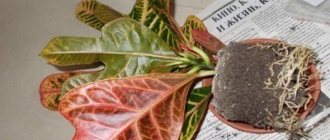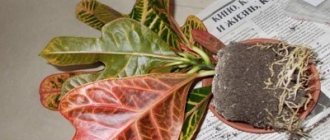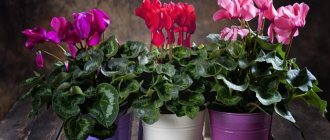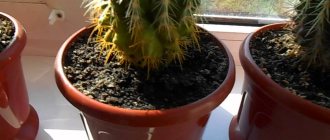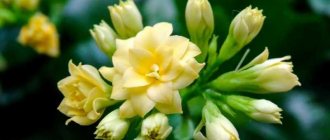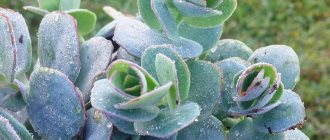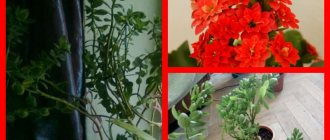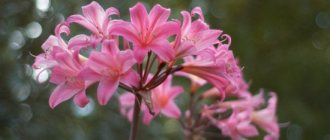What to look for when buying Kalanchoe
If you are going to immediately use the plant for medicinal purposes, you need to take it from friends or your grandmother at the nearest market, and not in a store. There, Kalanchoe is definitely stuffed with fertilizers or stimulants, which will not bring anything good to a person.
When purchasing decorative species, you need to pay attention to the following:
- The leaves should not have spots, spots, rot, or any other damage. Not often, but even reputable stores can receive a batch of plants infected with pests or diseases. No one will throw them away - this is a complete loss. Most likely, the flowers will be treated with a heavy dose of pesticides. But traces will remain, and, possibly, spores or larvae “hidden” in the leaf axils, substrate. Not only will gardeners bring an infected plant into the house, but it will also be weakened by a double or triple dose of the chemical.
- The leaves are elastic, uniform in color. The exception is variegated varieties. There should be no bald spots on the pubescent plates of Kalanchoe Becharian or Felt.
- A good sign is a point of growth in development.
- It is better to refuse the purchase if the Kalanchoe pot is too big. The crop is always sold in cramped shipping containers. The question arises: why was the Kalanchoe replanted?
- Experienced flower growers rarely buy a new plant (except for a very coveted one) unless they allow you to take the bush out of the pot and examine the roots. They should be white or dark straw-colored; a small number of dried shoots are allowed, but not rotten ones. The soil for Kalanchoe smells fresh, but should not stink - this is a clear sign of damage to the root system. Most likely, even if you immediately replant a plant from foul-smelling soil, it will not survive.
- The crop can easily be made to produce buds at any time, so you can buy flowering Kalanchoe not only in winter. It is better if the corollas are closed - by their color it is easy to see what the blossoming buds will be like. This way, at the peak of its decorative potential, the plant will last as long as possible. Bushes in full bloom look better, but will soon wither, especially since they will be exposed to stress from changing conditions.
Advice for transporting purchased Kalanchoe home in winter or late autumn:
- Ask the seller to wrap the entire flower in paper, for example, newspaper purchased in a nearby department.
- Place the Kalanchoe in a large bag.
- Inflate him.
- Tie so that no air escapes.
- Upon arrival home, first remove the bag, and after half an hour - the newspaper. All this time the flower should stand in the hallway.
- The next day it should not be transplanted, but quarantined.
The danger of purchasing Kalanchoe from hand is that it will be a cutting with poorly developed roots.
Kalanchoe - can you keep it at home: the meaning of the flower, signs and superstitions
A blooming Kalanchoe in an eco-bag is an excellent gift for all occasions.
Kalanchoe has medicinal qualities and is beneficial for humans. Therefore, be sure to get yourself this plant. It is quite patient and accepts minimal self-care with gratitude.
As for signs, they all have a positive meaning. Kalanchoe is not a magnet for dark forces, outbreaks of quarrels and abuse, diseases and troubles.
Vice versa:
- Kalanchoe absorbs heavy energy accumulated at the end of your working day
- cleanses the aura of the house, removes negativity from space
- promotes harmonization of family relationships
- encourages changing negative thoughts to positive ones
- brings the family together for pleasant conversations
- if your Kalanchoe blooms, it means that harmony, peace and harmony reign in the house
However, think about it if:
- your green pet suddenly began to fade and died, which means he took upon himself an external dark attack aimed at destroying the harmony of your family,
- it has been living with you for many years and does not bloom, which means there is a lack of sincerity, depth of relationships, and harmony in your family.
When to replant
Seedlings and rooted cuttings will have to be replanted several times in the first season. The culture develops, grows green mass and roots quickly, after a year it is considered an adult plant:
- decorative deciduous Kalanchoe species should be planted in a new pot once every 2 years;
- beautifully flowering ones are often thrown away after losing their decorative properties, taking cuttings for propagation;
- if the owners feel sorry for the faded plant, or need to preserve the mother bush, they replant it annually.
It is better to transplant Kalanchoe at home in the spring. But this is an amazingly flexible crop; you can transfer a flower to another pot regardless of the time of year.
True, there are nuances in terms of timing depending on the method by which the owners are going to replant the plant. Actions during flowering will be discussed in the next chapter. Now we will talk about decorative foliage, medicinal species, and Kalanchoe, whose corollas have already withered or do not yet have buds:
- Transplantation after purchase must be done regardless of the season, no earlier than after 2 weeks of quarantine. The method is partial transshipment. This way, the Kalanchoe will not end up with completely bare roots, but the shoots will not “pupate” in the transport peat, but will be forced to germinate into a fresh substrate.
- A complete transshipment is done at any time - this is the least traumatic method. It’s just that spring transplantation of Kalanchoe is always painless. It is better to plan the operation at the beginning of the season, but if you don’t have time, forget it - no special problems are expected even in the fall.
- The entire soil for Kalanchoe is changed in the spring. Here the root system will definitely be injured, and regeneration at the beginning of the growing season is especially fast. At other times, you can replant a flower in this way only in emergency cases.
The reasons for an emergency move to a new pot with a complete replacement of the substrate are the following reasons:
- the soil has deteriorated - it has turned sour, it is too compacted, it smells bad, it is so salty that removing the top layer does not help;
- soil pests have infested;
- the bush has been flooded, it can only be saved if it is replanted, pulled out of the pot, dried and (or) stripped of the exposed root.
The culture can be propagated at any time. When the Kalanchoe cuttings have outgrown and cannot wait until spring, they need to be transplanted from clean sand or perlite into a nutrient substrate. In a peat-sand mixture, a seedling or cutting will live as long as necessary.
Rules of care
Watering
This flower is able to accumulate moisture in the leaves, so it is important to water it properly. It calmly tolerates forced drought, but may begin to die from overwatering.
When watering, you need to wet the soil well, and the excess that drains into the pan must be drained immediately. The soil should have time to dry out between waterings. In summer, water procedures are carried out more often, and during wintering they are watered no more than once every 10 days. If a homemade Kalanchoe is flooded, its roots will begin to rot and mold will appear.
Fertilizer
This flower needs feeding monthly. It is better to fertilize flowering species with complex fertilizers, only take half the recommended dose on the package. You cannot feed the plant in winter.
Reproduction
Reproduction also means caring for your home Kalanchoe. This flower is propagated in several ways:
- dividing a large bush;
- cuttings;
- leaf planting;
- seeds.
If you have already grown a large bush and need to refresh it, you can separate a part from it and replant it separately. However, it is not always possible to revive a flower after such a “trauma”. The easiest way to propagate is from cuttings. The young stem quickly develops a root system, and if you care for it properly, within a month a lush bush will grow on the windowsill. You can also plant a separate leaf. This planting material takes root quickly, but it will turn into a beautiful plant only after a year. Kalanchoe is also propagated by seeds. True, the seed of this plant is very small, so you don’t need to sprinkle it with soil, just press it in. Then cover the pot with a bag to create your own microclimate for the seeds. They require indirect sunlight to germinate. The pot is placed in a warm place. The bag is removed only when the first shoots appear. Continue growing in a sunny place.
Trimming
To grow a beautiful indoor plant, it needs to be pruned from time to time. In addition, this procedure will help preserve the flower's strength. It is imperative to remove all lower peduncles. Old parts of the plant and wilted leaves must be cut off. In summer, pinch off the top to form side shoots.
Is it possible to replant during the flowering period?
It is highly undesirable to plant flowering plants in a new pot, including Kalanchoe. All certified specialists write about this. But the Internet is full of instructions on how to properly transplant Kalanchoe with buds. Apparently, the question requires careful clarification.
The most “burning” problem is what to do after purchasing beautifully flowering species at the peak of decorativeness:
- For some reason, many people think that if the operation is not carried out immediately, the bush will immediately drop its buds and die. And they don’t remember how stores organize sales of faded Kalanchoe blossfeldiana, which they will no longer buy at the same price. Do caring owners really care for Kalanchoe worse than sellers? Or does someone think that the preservation of decorativeness is facilitated by a lack of light, drafts, rearrangements, pawing with dirty hands in order to “feel the leaves”?
- To replant from a transport substrate, some of the roots will have to be freed, otherwise there is a high probability that they will not grow into fresh soil. Kalanchoe will not tolerate flowering and root regeneration at the same time. And it will drop its buds if it doesn’t die.
- Flowering bushes are often purchased in autumn or winter. The lower processes continue to develop at this time, but slowly. Regular transshipment is useless; if you replant Kalanchoe with partial or complete replacement of the substrate, the likelihood of the flower dying increases, and the buds will fall off.
If the owners choose a healthy bush in the store, nothing will happen to it. It is better to wait and replant it after flowering. After another couple of weeks, prune and use the remaining cuttings for propagation.
In the West, flowering Kalanchoes are generally bought as a bouquet plant. They don’t even think about planting other soil, and after losing its decorative properties, they throw it away.
Self-grown Kalanchoe can be replanted as planned. It is not clear why to do this during the flowering period. In the event of an emergency - the soil is damaged or for other reasons described in the previous chapter, the Kalanchoe will drop its buds on its own, or the owners will have to tear them off. For the plant to survive, there is no time for flowering here.
Reasons why Kalanchoe needs replanting
The medicinal properties of Kalanchoe have been known since ancient times, and its ability to reproduce is hardly comparable to any other plant. Extremely unpretentious, adaptable to any conditions, both in the sun and in the shade. As a succulent, it prefers well-lit places and poor soil. The reasons why it is transplanted more often than others are its intensive growth and rapidity of spread.
Young plants bordering the leaves fall to the soil and are guaranteed to take root. If you do not plant them, then after a while a “plantation” of Kalanchoe will form in the pot.
Species grown in indoor floriculture:
- Dergemona,
- Cirrus,
- Kalandiva,
- Blossfeld,
- Laciniata,
- Beharskoe,
- Felt,
- Tubeflower
Tip #1. When a bush grows too densely, it must be thinned out, otherwise the excessive green mass will not allow the plant to bloom.
How to replant Kalanchoe at home
This is a resilient culture. If the soil for Kalanchoe and the pot are chosen correctly, the bush is not disturbed during flowering, the operation usually takes place without complications. The biggest problem will be the loss of several leaves, which are so fragile that they break easily, even if planted carefully.
What kind of soil is needed for Kalanchoe
The culture is undemanding and grows well on light, low-nutrient soils with a neutral or slightly acidic reaction. The statement that the soil is suitable for Kalanchoe is alkaline, and the advice to add lime to the substrate, should remain on the conscience of the authors.
For decorative foliage and medicinal species, you can buy a ready-made substrate “Cacti and succulents”. There is no need to add additional sand.
If flowering species are obviously not fertilized, or are fed occasionally, for example, in offices, Kalanchoe needs more nutritious soil. You can take a ready-made one, for beautifully flowering plants, add 20% sand or perlite.
If desired, make the mixture yourself from equal parts:
- peat;
- turf land;
- leaf soil;
- rotted humus;
- sand or perlite.
To replant Kalanchoe, you cannot take soil from the garden! It is definitely infected with pathogens and pest larvae.
What kind of pot is needed for Kalanchoe
In a large container, the culture first grows roots, only then does the above-ground part begin to develop, and flowering is delayed. The worst case scenario is that the plant dies due to acidification of the soil and rotting roots, since it cannot “drink” the water between waterings. The top layer dries out, the bottom part remains wet.
An exception is that you can transplant 3-5 cuttings of beautiful flowering species into a wide low bowl for greater decorativeness.
For Kalanchoe, a regular-shaped pot made of plastic or unglazed clay is suitable. Size: approximately 2 cm larger than the previous container. If you place one inside the other, your index finger should fit between the walls.
Important terms:
- Bottom holes are required in the bottom of the pot;
- We must not forget about drainage - it prevents the substrate from becoming soaked and increases aeration.
For stability, it is better to put heavy, pre-washed gravel in the bottom of a pot with a large Kalanchoe for stability.
Step-by-step instructions for transplantation
The operation is simple, the culture is stable, but it does not need unnecessary damage to the root system. To minimize problems, it is important to choose the method for planting Kalanchoe correctly:
- simple transshipment - the flower grows in good soil;
- partial transshipment - after the purchase, the surface of the soil was covered with a salt coating, but in general the soil was good, the roots were intertwined into a tight lump;
- It is only necessary to completely replant a Kalanchoe if the substrate is damaged or pests have infested it, or the roots are rotting.
Transshipment
The simplest operation, step by step:
- A flower is taken out of an old pot.
- Drainage and some fresh substrate are poured into the new one.
- An earthen lump is installed in the center.
- Soil is added to the sides so that the Kalanchoe is at the same level as before. The old lump should be covered with a layer of substrate about half a centimeter.
- They crush it with their fingers.
- Water until water comes out through the drainage holes.
- Add soil.
Partial transshipment
Most often, the bush needs to be replanted in this way. It differs from the previous one only in that:
- the lump is kneaded to remove about a third of the old substrate;
- when planting, straighten the roots;
- the top layer of soil is larger, depending on how much of the old soil the owners removed.
Complete transplant
It is carried out in emergency cases when the flower needs to be saved. The roots are completely freed from the old substrate. If necessary, the shoots are washed and stripped down to living tissue.
The cut roots are sprinkled with crushed activated carbon. Kalanchoe must first be kept in the shade and in a well-ventilated area for 1-2 days. Only then transplant it into a new pot of the same or slightly smaller size - it depends on how much the roots have lost in volume.
What to do if there are several flowers growing in a pot
Sometimes, for advertising purposes, several flowers are sold to make the bush more lush. They are planted in one pot, where there is not enough space for all the roots to develop. Such bushes also need to be replanted immediately. The complexity of the process is explained by the need to separate each plant. They try to destroy the earthen lump after abundant moisture. This must be done carefully. When the roots are left bare, they are unraveled. Each separated seedling is transplanted into separate pots.
Advice! If it is impossible to sprinkle the earthen lump with your hands, you can easily get rid of it by washing it with warm water.
Reproduction by leaves and leaf blades
Some plant species have amazing properties. They can sprout not only from leaves and stems, but also from parts of leaf blades. Just plant a piece and it will give roots.
This type of reproduction will require special care. Since violation of technology will only lead to the sheet rotting. To begin, prepare a special soil mixture.
It will require leaf soil, humus, peat - they are taken in equal parts and mixed. Additionally, half of the river sand is added. This composition retains moisture for a long time.
The mixture is poured into a small pot and moistened well. A healthy leaf without a root is cut off from Kalanchoe. After which the plate is gently pressed into the soil.
Attention! It is important not to damage the sheet at this moment, otherwise it will begin to rot. The cut area is carefully covered with earth. Cover the pot with glass or a bag
It is necessary to control the level of soil moisture. Under the right conditions, a baby will form on the leaf plate
The pot is covered with glass or a bag. It is necessary to control the level of soil moisture. Under the right conditions, a baby will form on the leaf plate
The cut area is carefully covered with earth. The pot is covered with glass or a bag. It is necessary to control the level of soil moisture. Under the right conditions, a baby will form on the leaf plate.
Gradually it will get stronger and can be transplanted into another container. The mother leaf will gradually die on its own and dry up. A full-fledged miniature specimen of Kalanchoe will remain.
This propagation method is suitable for all varieties with fleshy, thick leaves. This option is very difficult, since if the technology is violated, the plate will rot or dry out. Therefore, you need to carefully monitor the condition of the seedling.
You can propagate Kalanchoe even with a piece of a leaf.
Leaf propagation
Some types of succulents grow well from a regular leaf. To do this, you need to cut off a healthy Kalanchoe leaf, along with the petiole - its length should be at least 2 cm.
After this, the cut is left to air dry. After which the leaf is planted in wet peat. The petiole is buried to its full length. It is advisable to cover the top of the pot with glass or cellophane.
For reference! Some claim that even a beginner can grow Kalanchoe from a leaf.
If you follow the technology, you can easily get a new plant specimen. You can try taking a fallen leaf for propagation. If it is not dry, it will produce roots.
Such a Kalanchoe will bloom only in a few years. Sometimes the leaf is germinated through water. To do this, it is placed in a container so that the petiole is constantly in contact with moisture.
After the roots appear, the leaf is carefully deepened into the soil for succulents for further strengthening.
How to propagate from cuttings and leaves
Propagation of Kalanchoe by cuttings is not only possible, but also necessary. During flowering, the stems stretch out, but when the Kalanchoe fades, the flowers fall off and the plant becomes somehow bald and inconspicuous.
Therefore, this elongated part of the shoot is cut off, placed in the ground and watered abundantly, or you can first germinate the roots in a container with water. You should carefully approach the choice of cuttings, since the further appearance of the plant and its shape will depend on the cuttings that you germinate.
You need to choose a straight shoot about 8 centimeters long with beautiful and even leaves and short internodes. The cuttings are planted in such a way that the leaves seem to lie directly on the surface of the soil.
When the cuttings have roots, you need to pinch the seedling - this will stimulate it to grow and further develop a lush Kalanchoe bush. Propagation by cuttings renews the plant itself and stimulates it to further growth and development.
Kalanchoes, which have fleshy leaves, can be propagated by leaflets. Any leaf is suitable for propagation, even an old one that has fallen off the trunk.
In order for roots to appear, you need to bury the stem of the leaf in damp sand and cover it with a transparent cap and place it in a bright place to create greenhouse conditions. Reproduction of Kalanchoe by leaves occurs best in late May and early June.
Method of propagation by seeds
Seeds are grown mainly for those species of Kalanchoe that are considered exotic and difficult to obtain.
To begin with, prepare the soil; this substrate should mainly consist of peat-sandy soil. The seeds are scattered on the surface of the substrate and covered with glass. This is best done at the end of winter or early spring.
The container, covered with glass, is placed in a bright place and the temperature is maintained at 20 degrees, this temperature is optimal for seed germination. Seedlings need to be watered and the seeds ventilated on time. After the seedlings become stronger, they are transplanted to a permanent place of growth.

